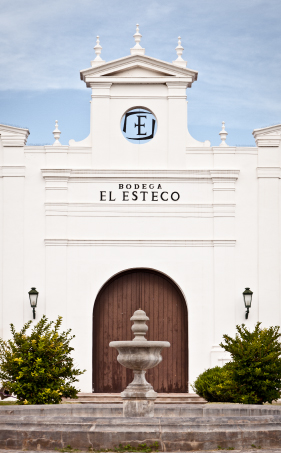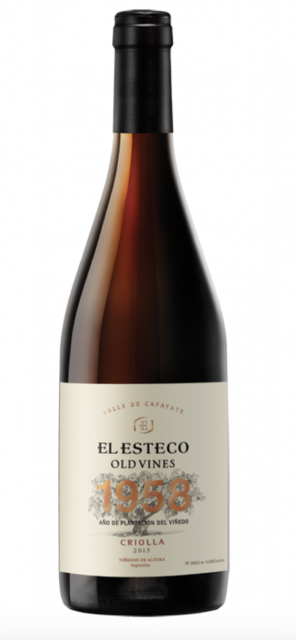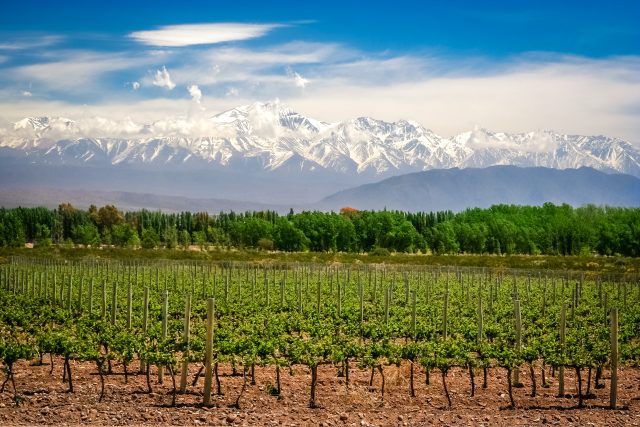This website uses cookies so that we can provide you with the best user experience possible. Cookie information is stored in your browser and performs functions such as recognising you when you return to our website and helping our team to understand which sections of the website you find most interesting and useful.
Summer sipping: Argentina’s Great Criolla Grape Revival
Argentina’s Criolla grapes – historical varieties native to the region – are making a comeback. And they are perfect for the summer.
Criolla is the name for the family of grapes that were formed from natural crosses between the first grapevine plants brought to Argentina by Spanish missionaries some 500 years ago. They include Torrontés (and its three aliases; Riojano, Mendocino and Sanjuanino), as well as Criolla Chica (AKA País/Mission), Criolla Grande and Cereza.

Many Criolla plantings have since been replaced by international varieties. But together they still account for a third of plantings. Today they are gaining greater attention, with more focus being placed on preserving and furthering their potential beyond high-volume, bulk wine production.
Torrontés has led Criolla exports with its quality improving hugely over the past decade as “white wines with flamboyant aromas and as orange wines with even more flamboyant aromas”, says Amanda Barnes, who has been writing about Criolla varieties for the past decade and is author of The South America Wine Guide.
Susana Balbo is one high profile producer that has been at the forefront of transforming perceptions of Torrontés, specifically with her Signature Barrel-Fermented Torrontés (and she is due to release an orange Torrontés, too).
But Torrontés is just the beginning.
An ‘authentic tasting experience’
Both Criolla Chica and Criolla Grande are capable of producing light, fragrant reds with elegance and finesse that are easy drinking and ideal for summer sipping. Cereza – the second most planted variety in Argentina after Malbec – is a pink-skinned variety, capable of producing light white and rosé wines with fresh fruit and floral aromas.
“Criolla varieties are the native varieties of South America and in my opinion they truly are one of the most authentic tasting experiences,” says Barnes. “Criolla wines have been in constant evolution, much like the other wines of Argentina, and I’m particularly excited to see this new wave of fresh, juicy and ultimately utterly gluggable white, red and orange Criolla wines in Argentina. I think they also tap into a trend here in the UK as drinkers start looking for more artisanal, unique and natural wines.”
Winemakers large and small are treating Criolla varieties with more care and attention, and the result is a growing range of still and sparkling to biologically aged, biodynamic and natural wines.

The Durigutti brothers, in Las Compuertas, Luján de Cuyo, Mendoza, are among those leading the Criolla revival, as the only winery producing a 100% Cereza under its Cara Sucia label, as well as a field blend called “Las Compuertas” Criolla Parral. Also in eastern Mendoza, in San Martin, is Matías Morcos (of the larger Bodega Morcos), who has created his own boutique line of wines under his own name made from Criolla and Moscatel.
Others include Cadus Wines, in Uco Valley’s Tupungato, whose winemaker Santiago Mayorga produces its Criolla Signature Series from 100% Criolla (Chica and Grande). Grapes are harvested from 70-year-old vineyards and fermented in concrete eggs.
While biodynamic producer Alpamanta produces a sparkling Pet Nat, ‘Breva’ made from Criolla Chica.
Paso a Paso Wines, based in Mendoza, was founded by friends Norberto Páez and Sebastián Bisole in 2008 from their garage. Now, the pair produce wines from across eastern Mendoza and the Uco Valley, including a Criolla Blanco field blend and a Criolla Grande Rosé blend.
Rocamadre is a boutique label founded by winemaker Juanfa Suaréz’ to explore the potential of Altamira in the Uco Valley. His Rocamadre Criolla is a 50/50 blend of Chica and Grande, made from 80-year-old vines planted 1,100 metres above sea level.
Larger producers are also seeing the potential. Catena Zapata has produced a limited edition run of three natural wines under the La Marchigiana label, including a 100% Criolla Chica, under the stewardship of Laura Catena and winemaker Alejandro Vigil.
Ancient vineyards
“These varieties are found in ancient vineyards, conserved and cultivated for many years by growers who have played a key role preserving this genetic diversity,” explains Jorge Prieto, researcher in grapevine ecophysiology at The National Institute of Agricultural Technology (INTA), which since 2012 has been conducting a study to identify Criolla varieties across Argentina.
“Nowadays, there are many winemakers (many of them young winemakers) who have been looking these last years for ancient vineyards, improving the agronomical management and the enological processes to produce more elegant, complex, fruity and easy-to-drink wines.”
Eastern Mendoza is the historical heartland of Criolla, but San Juan is also growing in prominence and home to a number of key producers.
Cara Sur, based in the valley of Calingasta, San Juan, is a partnership between Francisco Bugallo and Sebastián Zuccardi, of Famila Zuccardi, producing boutique wines from Criolla Chica and Moscatel. They also produce a field blend under the label Los Nidos – a 0.5ha parcel of old vines. Finca Las Moras, also in San Juan, produces a Pedro Gimenez aged under flor called Pedrito.
Producers in the northern region of Salta too are harnessing the potential of Criolla varieties, using its altitude and vine age to produce examples that stand in contrast to their southern counterparts.


El Esteco in Salta produces an Old Vine Torrontes 1945, which is fermented in concrete eggs and hand harvested from pergola vines.
It also produces its El Esteco Old Vines Criolla 1958. Grapes are hand-picked and fermented in 3,000l concrete eggs, resulting in an “intense, fruity rosé wine, with some fine lees in suspension that give a delicate mineral sensation,” says Francisco Xavier Tellechea, viticulturist at El Esteco.
“This Criolla is planted in pergola trellis and is used for the ‘Old vines’ wines (plot #27 from Las Mercedes),” he adds.
“The most important part of El Esteco Criolla plots is that they are mixed with Torrontés vines that were planted in 1956, but the Criolla ones are coming from the end of the 19th century (at the time of El Esteco’s founding). From a viticultural perspective, we are talking about truly old vines that represent the heritage of the Calchaquí Valley and its pioneers.”
Nearby, Vallisto Extremo is the work of winemaker Francisco (Pancho) Lavaque, whose family has long produced wines in Cafayate, Salta. His project focuses on smaller, lesser-known varieties, including a Criolla Chica grown at a vineyard in Hualfin, Catamarca province, at 2,600m above sea level and planted in 1898.
Criolla exports to UK rising
In the UK, Criolla imports are increasing, with Aldi recently adding a £5.99 Criolla Grande to its shelves, Buenas Vides Argentinian Criolla – a first for a UK supermarket.
La Cayetana is a boutique project founded by Emilia Soler (who’s husband Eduardo is behind Ver Sacrum). In setting up the project, her aim was to rescue old vineyards and traditional winemaking methods. Among the wines produced is a Criolla Blanca (Pedro Giménez), aged under flor and which is available in the UK.
Winemaker Mauricio Lorca produces a 100% Pedro Giménez and Criolla Grande under his Recoleta label, both of which are available in the UK.
“[Criolla varieties] offer the ultimate counterpart to the fuller bodied Malbec and red blends of Argentina, which are often best enjoyed with food,” adds Barnes. “I love nothing more than drinking a chilled bottle of Criolla wine during the summer evenings – when I’m in Argentina Criolla wines are my summer wine of choice to enjoy in the garden, by the pool or in the mountains.”

New varieties unique to Argentina
So, Criolla varieties are versatile, approachable and among the oldest planted in Argentina. Supporting their production also means supporting the preservation of a significant chunk of Argentina’s wine heritage and culture, stresses Barnes.
But there is still much to learn. The INTA is working to document all Criolla varieties, with 50 so far identified and cultivated at its vineyard in Mendoza.
In doing so, the team has proved there is much more variation in the Criolla ‘family’ than thought. Before conducting the study, it was believed that most Criollas were the result of crossings between Criolla Chica and Muscat of Alexandria. However, its study found a variety of different parents.
“We found for example, that some of them are related to Malbec, our emblematic variety,” says Prieto, who is part of the team leading the study. “So we expect that these varieties might increase the diversity of products offered by our country.”
Many of the samples tested were found to be completely different varieties, with 18 never genotyped before, leading the team to believe they were unique to Argentina.
“We published a first paper four years ago and we are now planning to publish a second paper in which we have identified several heritage-varieties found in ancient vineyards located in isolated valleys along the Andes mountains, from Mendoza to Salta,” adds Prieto.
This study will help to demonstrate the diversity within the Criolla family, and also extend Argentine’s wider winemaking potential, allowing for a greater understanding of the oenological properties of native varieties and their capabilities across the winemaking spectrum.
Enthusiasm among winemakers for Criolla is growing, and momentum is building throughout export markets too. For winemakers, making use of the genetic material that’s already established and adapted to Argentina’s climate is a no brainer. Challenges remain, but the path looks clear for Argentina’s brilliant native varieties to thrive.

